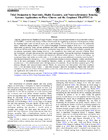Tidal dissipation in dual-body, highly eccentric, and nonsynchronously rotating systems: Applications to Pluto-Charon and the exoplanet TRAPPIST-1e
Abstract
Using the Andrade-derived Sundberg-Cooper rheology, we apply several improvements to the secular tidal evolution of TRAPPIST-1e and the early history of Pluto-Charon under the simplifying assumption of homogeneous bodies. By including higher-order eccentricity terms (up to and including e20), we find divergences from the traditionally used e2 truncation starting around e=0.1. Order-of-magnitude differences begin to occur for e>0.6. Critically, higher-order eccentricity terms activate additional spin-orbit resonances. Worlds experiencing nonsynchronous rotation can fall into and out of these resonances, altering their long-term evolution. Nonzero obliquity generally does not generate significantly higher heating; however, it can considerably alter orbital and rotational evolution. Much like eccentricity, obliquity can activate new tidal modes and resonances. Tracking the dual-body dissipation within Pluto and Charon leads to faster evolution and dramatically different orbital outcomes. Based on our findings, we recommend future tidal studies on worlds with e≥0.3 to take into account additional eccentricity terms beyond e2. This threshold should be lowered to e>0.1 if nonsynchronous rotation or nonzero obliquity is under consideration. Due to the poor convergence of the eccentricity functions, studies on worlds that may experience very high eccentricity (e≥0.6) should include terms with high powers of eccentricity. We provide these equations up to e10 for arbitrary obliquity and nonsynchronous rotation. Finally, the assumption that short-period, solid-body exoplanets with e≥0.1 are tidally locked in their 1:1 spin-orbit resonance should be reconsidered. Higher-order spin-orbit resonances can exist even at these relatively modest eccentricities, while previous studies have found such resonances can significantly alter stellar-driven climate. Show more
Permanent link
https://doi.org/10.3929/ethz-b-000513743Publication status
publishedExternal links
Journal / series
The Planetary Science JournalVolume
Pages / Article No.
Publisher
IOP PublishingMore
Show all metadata



